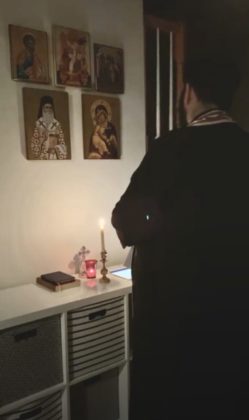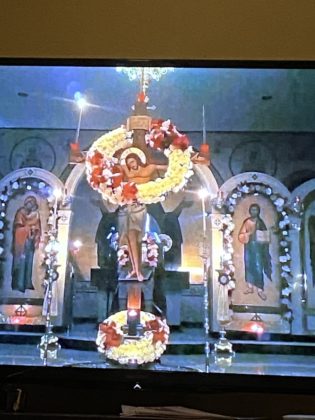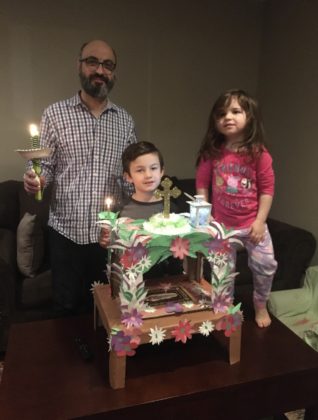- George Marcus, Greek-American Philanthropist & Entrepreneur
- “New Shoes!” American postwar humanitarianism in the papers of Anna Howell Hayward (1908–2001)
- ΘΕΙΑ ΦΩΤΩ (AUNT PHOTO) AND HER OXI
- Demi Lovato finds her inner ‘Child Star’ voice with new Hulu documentary
- Hellenic Film Society Closes Out a Successful Run of NY Greek Film Expo 2024
Virtual Chuch: A Lifeline in the Time of Covid-19
By Maria A. Karamitsos
In difficult times, we seek comfort in our faith. This year, with the COVID-19 pandemic, which forced the closure of schools, businesses, and even churches, our faith has been tested. With shelter-in-place orders in effect, Christians around the world lament the closing of their churches, especially during Lent. Fortunately, in 2020, we have the technology to bring church into our homes. From our smartphones and other devices, to streaming on our television screens via Facebook, YouTube, and parish websites, church is still available to us. Families were inspired to create their own little churches at home, and even build their own Epitaphio.
In Chicago, our parishes were closed on March 15. A woman who wished to be identified only by her first name, Christina, spoke about this. “We felt like we were lost at sea. We didn’t have the comfort of our church. We couldn’t hear the voices of our beloved priests to calm us in the storm,” she recalled. “That morning on Facebook, I stumbled upon Liturgies streamed from North Carolina and Atlanta. I needed this. It was nice to see other churches, and our Faith celebration continuing.”
Later, churches of the Metropolis of Chicago received permission to celebrate services, however, in accordance with Illinois Governor J.B. Pritzker’s order, no parishioners could attend. Personally, it is heartening to see and hear the voices of our priests, though startling to see empty churches. We long to be there, now more than ever.
Technology also afforded the opportunity to reach out to people around the country – and in Greece – to get their thoughts on “virtual church” and what it’s meant to them during this unprecedented time, and certainly, the impact during the Lenten season. Here’s what I learned.
Creative priests
Without the ability to go to church to celebrate Divine Liturgy or other Lenten services, priests got creative. Presvyteres became camerapeople and occasionally, priests’ families chanted. Many streamed prayer services from their homes. Others held Facebook Live discussions with their parishioners, on topics relating to Lent, or simply to pray together and offer words of encouragement. The Metropolis of Chicago now hosts discussions with various theologians, streamed on Facebook. Also in Chicago, Metropolitan Nathanael and clergy post video messages to the faithful. And the faithful responded, tuning in, and often. Sunday schools, ministries, and youth groups meet in Zoom meetings, to see and hear each other, and offer prayers and activities. These meetings are taking place in other Metropolises and in other Orthodox jurisdictions as well.

Father Nektarios Karantonis, Associate Priest at St. Nectarios Greek Orthodox Church in Charlotte, NC observes a Nightly Prayer Service for Protection from COVID-19 from his home. FACEBOOK SCREENSHOT
“I tuned in to priests around the country, and even from other Orthodox jurisdictions via Facebook,” Ann from Chicago shared. “I watched afternoon discussions with Father Chris Mihalopoulos from St. Nectarios in Palatine, IL; evening prayers from Father Nektarios Karantonis’ home in North Carolina. Father Paul Jannakos from St. Luke Orthodox Christian Church in Palos Hills, IL did services from his home. I liked seeing what everyone was doing. Their words meant so much to me.”
The Archdiocese and Metropolises responded quickly, offering online resources to help the faithful, to not only get through the uncertainty of each day, but to mark points in the Lenten period.
“I’m so pleased to see online Orthodox resources, from the text of full services, to the writings of Byzantine scholars. I find that now as I’m preparing to watch services, I’m studying Orthodox Faith more with these resources,” said Meletios Poulopoulos of New Hampshire. “It’s a pleasure also to visit other communities online – and attend with friends all over the country. The thing I miss the most is hearing our beautiful choirs. Thankfully, we have many historic recordings we can go to for that inspiration.” Meletios also noted that with the services online, he schedules them as he would a meeting. “Then when I attend online, my attention is dedicated.”
“The online interviews and discussions were a great way to get to know the various hierarchs,” Kristy Brown from Elmhurst, IL shared. “Our OCA (Orthodox Church of America) Bishop Paul hosted a Zoom meeting with parents. He asked us what we needed. We discussed how to keep the kids engaged. I think people will now look for more ways to be connected.”
“Our church didn’t have livestream before,” said Toni Milak, from Holy Apostles Church in Westchester, IL. “We watched other churches before ours was up and running. It was incredible to see how many people logged in. We were moved by how this was connecting people when suddenly we were forced apart.”

Anastasi service streamed on Facebook from the Archdiocese in New York, officiated by His Eminence Archbishop Elpidophoros. FACEBOOK SCREENSHOT
Priests heard confessions by phone. In addition to Zoom, they check in with parishioners via FaceTime and Skype. Unable to enter hospitals, via video calls priests offered prayers and comfort to those afflicted or dying in quarantine. Some parishes previously offered livestream for shut-ins and limited online resources, but for the greater percentage, this was all new.
Watching church at home
Having the ability to watch church from home has been a lifeline, though all agree, it’s difficult to give full attention and focus as we do in church. We’re missing the communal atmosphere, the icons, our church family, the sights and smells, the time away from the rest of the world. We’re missing the Eucharist. But families are doing their best under the circumstances.
“We set up a home chapel where we meet. We close the curtains, have one light. Our priest emailed texts which I print so we all follow long. We try to make it as much like church as we can,” added Kristy Brown. “We sing the responses. We kneel, we stand when appropriate. It’s been a challenge with all the distractions at home, but even more so because on these days leading to Anastasi, we are all-in physically at church. It makes us realize what we’re really missing. This is no substitute for church, but it’s good. We are now like ‘Church in Exile’.”

Holy Friday in the living room with service streamed on YouTube to a television. PHOTO: MARIA A. KARAMITSOS
Some parents have taken the time to “shorten” the Liturgy or read Bridegroom services with their children like story time. Most agreed that it was challenging to get kids to stand or kneel, and to keep everyone focused with the distractions of home.
“My kids do the readings. My son chants. We all followed along in a booklet,” added Toni Milak. “My kids love burning incense every night. It’s hard to recreate that feeling you have in church, but we’re doing our best. We’re grateful for what we have.”
Orthodox faithful are thankful for the opportunity to continue their worship practice and “meet” with their church families, though they are physically apart. Many said the availability of services and discussions helps them through this crisis.
“The church is my rock,” said Hara Anastopoulou of Chicago. “In his sermons and explanations of the Bible readings, our priest relates everything to our current situation.”
Others echoed her statements and said that without these opportunities they would be lost. Gus Constantine of New York shared that even as an adult, his participation level isn’t the same since he isn’t physically in church. “I’ve watched more because there is more to watch, but I don’t celebrate the Liturgy as I would in church. I cannot emphasize how sad it is to see church going on with empty pews. It’s eerie to watch.”
Increased participation
With more services available online, the greater percentage of people I communicated with said they were participating in more services than usual.
Some shared that during this crisis, they’re reading the scriptures and devotionals more. Many listen to services while they work or while doing activities with kids. Kathy from Los Angeles said she plays the services loud in the house, so her family knows that God and the Church are always there. “I like to think that something is getting absorbed. For me to do this, I’m planning and listening more. After all the scary news reports, I go to YouTube and play chants. It settles me and eases the fear.”

The Dagiantis Family of Naperville, IL built their own Epitaphios, designed by 8 year-old Panayiotis (center). The family processed with it outside on Holy Friday night. PHOTO COURTESY DAGIANTIS FAMILY
Several moms said that this shutdown occurring during Lent was opportune, as their children typically are busy with activities and school. They now watch and participate in services they would have otherwise missed.
Some say they are attending the same number of services they would during Lent and Holy Week, but they appreciate that they can watch the playback if for some reason they can’t view it. “I have teenagers,” shared Tina Pappas of Florida. “It’s difficult to get them up for church. Now I can play it back later and we miss it.”
Others shared that with the shelter-in-place, they have time to participate in a wider variety of services, more than in years past. One woman who wished to remain anonymous, said that she watched Great Compline and Paraklesis services, something she hadn’t done before, simply because she didn’t have time.
Magdaline Makris, a New Yorker living in Greece, shared that since she works in the morning, online services allow her to attend church regularly. “I can listen to more Liturgies and also it’s an excuse for me to have my teenagers listen to the echoing sounds of church hymns and prayers.”
A friend in Athens remarked that she enjoys watching online services from Jerusalem, Constantinople, and other cities in Greece.
Indifference
A few people I spoke to indicated that they hadn’t been particularly religious before, so even though they are home and have the time, they aren’t tuning in. One person, who wished to remain anonymous, said he chose not to watch from home because “It’s not church.” He said he’ll “keep the memories of past years in my heart.”
Online services bring people back to the Church
Some shared that they had been estranged from the Church, but online Liturgies and resources have brought them back. “I’ve been away from the Church for more than 25 years,” said a woman who wished to be identified only by her first name, Georgia. “I’ve moved during that time. I’m shy and didn’t want to go to a new parish alone. I stumbled upon a service on Facebook. I watched. I remembered how the Liturgy made me feel. I’d forgotten how beautiful and uplifting our services are. I watched at home, without feeling self-conscious. I’ve been watching various churches now, every Sunday, and have heard some discussions. I feel like Church has come to me; it’s found me. When this is over, I will find a parish to attend.”

Meme circulating on Facebook. Creator unknown.
A church in every home
A meme has been going around Facebook with the devil and God. The devil says, “With COVID-19, I closed your churches!” God’s response: “On the contrary. I just opened one in every home!” Technology brought church to us, and with it, strength. The faithful are eager to physically return to church to worship with their parish families, and of course, to receive communion. They say that given the choice, they’ll physically go to church, but appreciate the option. During the Spanish Flu pandemic 100 years ago, there was no such technology to keep people connected. We are blessed, indeed, for the opportunity to see, hear, connect, and learn in novel ways. Overall, people are thankful to have these resources at their fingertips. Though “virtual church” is not a substitute for physical attendance and participation, it’s been a lifeline for the faithful.
Once the world “opens”, let us remember the little church in which we celebrated in our home. It’s an extension of our parish, of our faith, our prayer life. Most people I spoke with said they hope the interviews and discussions will continue, for they’ve learned so much, and have joined a new extended church family across the miles, across the web.
——-

Maria A. Karamitsos
Maria A. Karamitsos has been a positive voice in Greek media since 2002. She was the Founder, Publisher, & Editor of WindyCity Greek magazine. For 10 years, she served as the Associate Editor & Senior Writer for The Greek Star newspaper. Her work has been published in GreekCircle magazine, The National Herald, GreekReporter, Harlots Sauce Radio, Women.Who.Write, Neo magazine, KPHTH magazine, XPAT ATHENS, and more. Maria has contributed to three books: Greektown Chicago: Its History, Its Recipes; The Chicago Area Ethnic Handbook; and the inaugural Voices of Hellenism Literary Journal. She’s working on her 1st novel.











0 comments